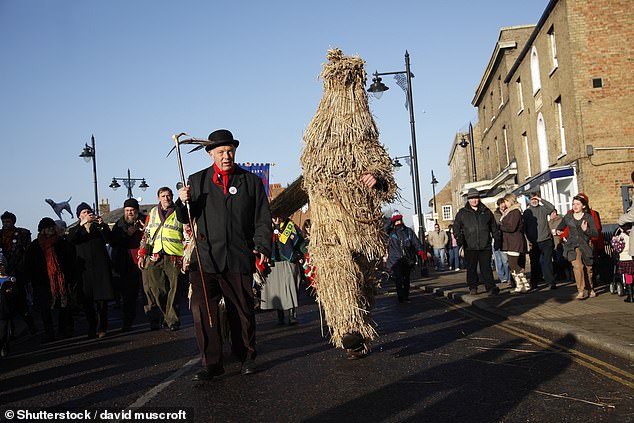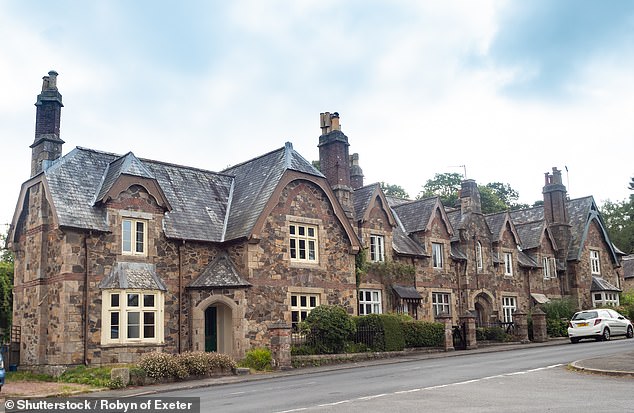Escape to the country… for less! House prices in these rural areas are cheaper than nearby cities and towns
Buying a house in the countryside is a dream for many homeowners, attracted by the idea of a peaceful rural idyll where they can get away from it all.
But the cost of doing this can be prohibitive. Prices rose during the pandemic as outdoor space shot to the top of many buyers’ wish lists and led to a flight away from big cities.
For those still looking for their perfect rural home, exclusive research from estate agent Jackson Stops has uncovered the areas of England where rural properties still offer a bargain compared to those in urban centres.
City or country? Research from Jackson Stops shows where it is cheaper to buy a detached home in the countryside than in the city
Topping the list is the east of England, including Cambridgeshire, Bedfordshire, Norfolk, Suffolk and Essex.
There, a detached house in the countryside costs on average £487,483, which is 37 per cent cheaper than the £772,396 they would normally pay for a similar property in a larger town or city.
The price gap has increased from 34 per cent before the pandemic, and is driven by a spike in house prices in sought-after cosmopolitan areas such as Cambridge.
Demand from detached house buyers looking for rural locations in the East of England has also fallen by 2 percentage points over the past decade, now at 54 percent compared to 56 percent in 2013. This means it could be easier to to make a bargain.
The rural location in the east of England that proved most popular with buyers in 2023 was Whittlesey, according to Jackson Stops.
Whittlesey, six miles east of Peterborough in the Fenland district of Cambridgeshire, has a population of almost 18,000 and has two historic churches and access to several local nature reserves.
It is also known for the annual ‘straw bear festival’ that takes place every January.
Also popular was Dersingham in Norfolk. The village is located just north of Sandringham, the favorite royal residence of Queen Elizabeth II.
It is also close to the Dersingham Bog National Nature Reserve, which is home to several rare plants and birds.
Nick Leeming, chairman of Jackson-Stops, said: “The East of England has grown in popularity over the past two years, home to the Cambridge-Oxford Arc as a melting pot for innovation and urban expansion.
‘While demand for rural hubs around Suffolk and Norfolk has increased thanks to the rise of flexible working and lifestyle trends, there remains plenty of opportunity here for buyers looking for the best of both worlds.’

Bear-y nice: Whittlesey in Cambridgeshire, home of the straw bear festival, is the most popular rural location for homebuyers in the east of England according to Jackson Stops
Daryl Parr, director of Jackson-Stops Colchester, added: “Essex remains one of the most affordable areas to live for people leaving London. This means that families can get a large, detached home in a green location within an hour of the capital.
‘There are houses that tick all the boxes and sell quickly – these are in the real diamonds of villages, in the heart of Constable Country, usually just behind an old church.
‘Hidden gem villages in the golden triangle between Ipswich, Chelmsford and Colchester are becoming increasingly popular with buyers, where countryside views abound.’
It is one of four areas where the price of a detached house in the countryside is cheaper than an urban home, along with the West Midlands, the North West and Yorkshire and the Humber.
The area where owners pay the biggest premium for a rural detached house is the South West, where it costs an average of £563,786 – 11 per cent higher than an urban detached house of £508,006. The difference has increased from 8 percent in 2022.
There, the most popular locations with country house buyers included Bishops Cleeve, Amesbury and Bovey Tracey.
Bishop’s Cleeve in Gloucestershire has a population of around 14,000 and is located at the foot of Cleeve Hill, the highest point in the Cotswolds.
It is home to The Grange, a business complex with offices for major companies including Zurich and Capita.
Amesbury in Wiltshire is possibly the oldest occupied settlement in Britain, first settled around 8820 BC. It is also home to Stonehenge.
Meanwhile, Bovey Tracey in Devon is a market town on the edge of the Dartmoor National Park.

Scenic view: Bishop’s Cleeve is located at the foot of Cleeve Hill in the Cotswolds
Rural homes are generally more expensive than urban homes
Looking at house prices in real terms, the price of a rural home – for all housing types, not just detached homes – has risen faster than for an urban home.
Jackson Stops research shows that buyers are consistently paying more for homes in rural areas – and that the price premium has increased over the past decade.
In 2013, a buyer would have to buy an average of 15 percent more for a rural home than for a city home in the same region, while this premium had risen to 18 percent in 2023.
The typical rural house now costs £347,278, up from £295,526.

Historic: Bovey Tracey in Devon is home to these traditional Dartmoor stone cottages
Jackson-Stops says this indicates a rising demand for rural living over the past decade.
The cheapest region to buy a rural house is the North East, where it costs an average of £182,014, while the South East is the most expensive at £500,271.
The South West has seen the biggest spike in rural house prices, rising 28 per cent in the past five years to £383,767.
This is thanks to the huge popularity of Cornwall, which topped Jackson Stops’ list of most popular locations for rural property seekers for the third time in three years.
In each of those years it was followed by Wiltshire and the East Riding of Yorkshire.
| Region | National house price 2018 (all house types) | National house price today | % change |
|---|---|---|---|
| East of England | £305,393 | £355,144 | +16% |
| East Midlands | £247,925 | £286,645 | +16% |
| North-East | £162,883 | £182,014 | +12% |
| North West | £211,767 | £246,567 | +16% |
| Southeast | £402,544 | £500,271 | +24% |
| South West | £298,695 | £383,767 | +28% |
| West Midlands | £258,111 | £312,432 | +21% |
| Yorkshire & Humber | £226,228 | £253,899 | +12% |
| All of England | £287,293 | £347,278 | +21% |
| Source: Jackson Stops/Cadastre | |||
Richard Holder, director of Jackson-Stops Cornwall, said: ‘The West Country has a long tradition of attracting all kinds of homebuyers from across the country, lured by rolling countryside and blissful beaches.
‘But Cornwall in particular is the kind of place that enchants you; the romance of Poldark is more than just on screen. The relaxing countryside, warm community feel and close connection to nature make Cornwall the ultimate retreat for country lovers.
‘Name any hamlet here and you will undoubtedly find a cobbled street lined with pretty cottages, surrounded by wildlife and heritage. It is a magnet for downsizers and entrepreneurs, who offer the good life in abundance.’
The research excluded London because it has no rural houses.
Prices are also falling faster in villages and cities than in rural areas. Last year, rural house prices in England fell by an average of 1 per cent or £3,615, but urban homes fell by almost double this amount: 2 per cent or £6,705.
However, country houses are not immune to price falls and most areas are still seeing declines.
The Southwest was the only area where prices rose 2 percent last year. They also remained the same in the southeast.
The area that saw the biggest fall was Yorkshire and the Humber, where prices fell 7 per cent in a year to £253,899, according to Jackson Stops.
However, house prices in rural areas are still 15 percent higher than in the cities.
Some links in this article may be affiliate links. If you click on it, we may earn a small commission. That helps us fund This Is Money and keep it free to use. We do not write articles to promote products. We do not allow a commercial relationship to compromise our editorial independence.
